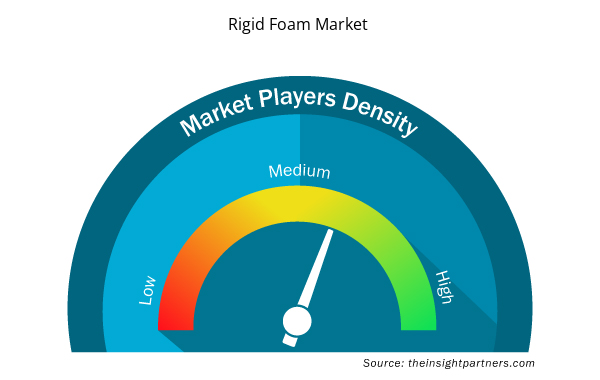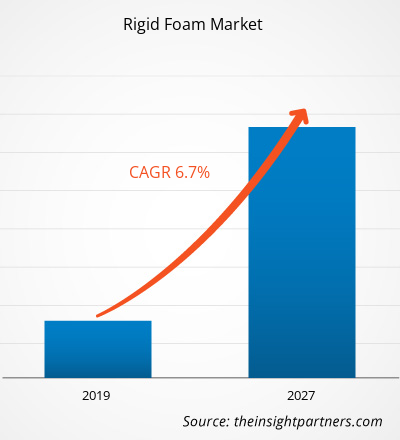[研究报告] 2018 年硬质泡沫市场规模为 737.867 亿美元,预计在 2019 年至 2027 年的预测期内复合年增长率为 6.7%,到 2027 年将达到 1315.589 亿美元。
众所周知,硬质泡沫具有防水、防静电、防震和防滑等多种特性,是许多工业和建筑行业的理想材料。硬质泡沫可保护其所应用的混凝土表面,并延长底层混凝土地板的使用寿命。它们对油、洗涤剂和清洁剂、变速箱油、水、冰雹、雪和腐蚀性化学品均无影响。硬质泡沫还用于改善地板的美观性。它们有多种颜色、色调和纹理可供选择。金属颜料和乙烯基彩色薄片被添加到硬质泡沫系统中,以产生具有彩虹色的表面。彩色硬质泡沫的美观性预计将推动硬质泡沫市场的发展,并越来越多地用于新住宅项目和旧房翻新。
2018 年,亚太地区占据全球硬质泡沫市场的最大份额。亚太地区市场的增长主要归因于该地区主要硬质泡沫制造商的存在。此外,硬质泡沫生产活动的增加预计将在 2019-2027 年推动市场增长。在亚太地区,就收入而言,中国占据硬质泡沫的最大份额。
定制此报告以满足您的需求
您可以免费定制任何报告,包括本报告的部分内容、国家级分析、Excel 数据包,以及为初创企业和大学提供优惠和折扣
- 获取此报告的关键市场趋势。这个免费样品将包括数据分析,从市场趋势到估计和预测。
市场洞察
采用基于生物聚乳酸废料的新型聚(乳酸-氨基甲酸酯-异氰脲酸酯)泡沫
近年来,随着塑料和聚合物产量的增加,聚合物领域取得了快速发展。聚合物行业呈上升趋势,预计将产生大量聚合物废物。此外,随着环境保护的兴起,新的规则和法规也应运而生,这促使科学家和企业家寻找管理和处理塑料废物的替代解决方案,或采用可在自然环境中分解的可生物降解塑料。在世界各地生产的几种可生物降解塑料中,聚乳酸 (PLA) 被认为是首选的生物塑料形式之一。这些塑料产生的废物可以轻松加工成全价值产品,例如硬质聚氨酯-聚异氰脲酸酯 (RPU/PIR) 泡沫。由可生物降解聚乳酸生产的此类泡沫被视为可持续解决方案。根据欧洲 PMC 提出的一项研究,聚乳酸可以部分替代聚异氰脲酸酯配方中的石化多元醇。此外,所获得的 PIR 泡沫具有几个特性,例如最小的表观密度、脆性和吸水能力。因此,使用由塑料废料组成的 PLA 多元醇可以成为石化多元醇的绝佳替代品。这种发展有助于管理稀缺资源并有助于有效利用废物。此外,由这种生物材料生产的产品被认为是环保解决方案。
类型洞察
根据类型,硬质泡沫市场分为聚氨酯泡沫、聚苯乙烯泡沫、聚丙烯泡沫、聚乙烯泡沫、聚氯乙烯泡沫等。聚氨酯泡沫占据了全球硬质泡沫市场的主导地位。硬质聚氨酯泡沫因其优异的绝缘性能和良好的尺寸稳定性而广泛应用于制冷、建筑和包装行业。
最终用途行业洞察
根据最终用途行业,硬质泡沫市场可分为建筑和施工、家电、包装、汽车和其他。建筑和施工部门在全球硬质泡沫市场中占有最大份额。它们在房屋和建筑物中的使用减少了建筑物、商店和办公室内部空间供暖和制冷所需的能源。预计建筑和建筑行业对硬质泡沫的消费量将在预测期内支持全球硬质泡沫市场的增长。
公司通常会采用多种策略来扩大其全球业务范围。亨斯迈公司、科思创、巴斯夫公司是全球硬质泡沫市场的主要参与者,它们实施这些策略来扩大客户群并获得显着的市场份额,从而使他们能够在全球范围内维护自己的品牌名称。
硬质泡沫市场区域洞察
Insight Partners 的分析师已详细解释了预测期内影响硬质泡沫市场的区域趋势和因素。本节还讨论了北美、欧洲、亚太地区、中东和非洲以及南美和中美洲的硬质泡沫市场细分和地理位置。

- 获取硬质泡沫市场的区域特定数据
硬质泡沫市场报告范围
| 报告属性 | 细节 |
|---|---|
| 2018 年市场规模 | 737.9亿美元 |
| 2027 年市场规模 | 1315.6亿美元 |
| 全球复合年增长率(2018 - 2027) | 6.7% |
| 史料 | 2016-2017 |
| 预测期 | 2019-2027 |
| 涵盖的领域 | 按类型
|
| 覆盖地区和国家 | 北美
|
| 市场领导者和主要公司简介 |
|
硬质泡沫市场参与者密度:了解其对业务动态的影响
硬质泡沫市场正在快速增长,这得益于最终用户需求的不断增长,这些需求源于消费者偏好的不断变化、技术进步以及对产品优势的认识不断提高等因素。随着需求的增加,企业正在扩大其产品范围,进行创新以满足消费者的需求,并利用新兴趋势,从而进一步推动市场增长。
市场参与者密度是指在特定市场或行业内运营的企业或公司的分布情况。它表明在给定市场空间中,相对于其规模或总市场价值,有多少竞争对手(市场参与者)存在。
在硬质泡沫市场运营的主要公司有:
- 阿玛斯国际控股有限公司
- 北欧化工公司
- 圣戈班公司
- 科思创公司
- 陶氏化学公司
免责声明:上面列出的公司没有按照任何特定顺序排列。

- 获取硬质泡沫市场顶级关键参与者概述
报告亮点
- 硬质泡沫市场不断发展的行业趋势有助于参与者制定有效的长期战略
- 发达市场和发展中市场采用的业务增长战略
- 2017 年至 2027 年硬质泡沫市场定量分析
- 各行业硬质泡沫需求量估算
- PEST 分析可说明行业内买家和供应商预测市场增长的有效性
- 了解竞争激烈的市场状况和硬质泡沫需求的最新发展
- 市场趋势和前景,以及推动和抑制硬质泡沫市场增长的因素
- 了解支撑硬质泡沫市场增长商业利益的战略,这有助于利益相关者在各个市场节点对硬质泡沫市场规模进行决策
- 硬质泡沫市场的详细概述和细分,以及行业动态
全球硬质泡沫市场 – 按类型
- 聚氨酯泡沫
- 聚苯乙烯泡沫塑料
- 聚丙烯泡沫
- 聚乙烯泡沫
- 聚氯乙烯泡沫
- 其他的
全球硬质泡沫市场 – 按最终用途行业划分
- 建筑和施工
- 家电
- 包装
- 汽车
- 其他的
公司简介
- 圣戈班
- 陶氏化学公司
- 巴斯夫
- 北欧化工公司
- 积水化学工业株式会社
- 科思创公司
- 阿乐斯国际公司
- 亨斯迈国际有限公司
- JSP
- Zotefoams 公司
- 历史分析(2 年)、基准年、预测(7 年)及复合年增长率
- PEST 和 SWOT 分析
- 市场规模价值/数量 - 全球、区域、国家
- 行业和竞争格局
- Excel 数据集


- Precast Concrete Market
- Fixed-Base Operator Market
- Retinal Imaging Devices Market
- Point of Care Diagnostics Market
- Biopharmaceutical Contract Manufacturing Market
- Influenza Vaccines Market
- Transdermal Drug Delivery System Market
- Data Annotation Tools Market
- Cell Line Development Market
- Dry Eye Products Market

Report Coverage
Revenue forecast, Company Analysis, Industry landscape, Growth factors, and Trends

Segment Covered
This text is related
to segments covered.

Regional Scope
North America, Europe, Asia Pacific, Middle East & Africa, South & Central America

Country Scope
This text is related
to country scope.
常见问题
Growing demand for rigid foam in the building and construction industry is one of the factors that has contributed to favor the rigid foam market all over the globe. Rigid foam sheaths are used as insulation materials to control indoor temperature and thereby reduce the building’s energy consumption. Rigid foams made from expanded polystyrene (EPS), extruded polystyrene (XPS), and polyisocyanurate are valued for their thermal insulation properties and offer durability and moisture control.
The Asia Pacific region led the rigid foam market with a market share of 44.4% in 2018. The continuous economic growth in developed and developing countries like India and China, coupled with the presence of huge disposable incomes with individuals in countries like Japan and Australia, has facilitated the rapid growth of the automotive industry in this region. The Asia Pacific is one of the world’s rapidly growing automotive markets, with China accounting for maximum car production. The rapid growth in industrialization and urbanization in the economy is positively impacting the growth of the rigid market in the APAC region. Moreover, the market for rigid foam is expected to rise with the growth of end-use industries.
The leading type of rigid foam was the polyurethane foam that was noted to account for a CAGR of 6.6%. Rigid polyurethane foam (PUF) is regarded as an efficient insulation material that is used to save energy. They have one of the highest thermal resistance value per inch of all commercially available insulating materials. The growing demand for polyurethane foam can be attributed to the rise in the consumption of insulation materials used in the building and construction sector and the HVAC and refrigeration industries.
Trends and growth analysis reports related to Chemicals and Materials : READ MORE..
The List of Companies
- ARMACELL INTERNATIONAL HOLDING GMBH
- BOREALIS AG
- COMPAGNIE DE SAINT-GOBAIN S.A.
- Covestro AG
- Dow Chemical Corporation
- Huntsman International LLC
- JSP
- BASF SE
- SEKISUI CHEMICAL CO., LTD.
- ZoteFoams Plc
The Insight Partners performs research in 4 major stages: Data Collection & Secondary Research, Primary Research, Data Analysis and Data Triangulation & Final Review.
- Data Collection and Secondary Research:
As a market research and consulting firm operating from a decade, we have published and advised several client across the globe. First step for any study will start with an assessment of currently available data and insights from existing reports. Further, historical and current market information is collected from Investor Presentations, Annual Reports, SEC Filings, etc., and other information related to company’s performance and market positioning are gathered from Paid Databases (Factiva, Hoovers, and Reuters) and various other publications available in public domain.
Several associations trade associates, technical forums, institutes, societies and organization are accessed to gain technical as well as market related insights through their publications such as research papers, blogs and press releases related to the studies are referred to get cues about the market. Further, white papers, journals, magazines, and other news articles published in last 3 years are scrutinized and analyzed to understand the current market trends.
- Primary Research:
The primarily interview analysis comprise of data obtained from industry participants interview and answers to survey questions gathered by in-house primary team.
For primary research, interviews are conducted with industry experts/CEOs/Marketing Managers/VPs/Subject Matter Experts from both demand and supply side to get a 360-degree view of the market. The primary team conducts several interviews based on the complexity of the markets to understand the various market trends and dynamics which makes research more credible and precise.
A typical research interview fulfils the following functions:
- Provides first-hand information on the market size, market trends, growth trends, competitive landscape, and outlook
- Validates and strengthens in-house secondary research findings
- Develops the analysis team’s expertise and market understanding
Primary research involves email interactions and telephone interviews for each market, category, segment, and sub-segment across geographies. The participants who typically take part in such a process include, but are not limited to:
- Industry participants: VPs, business development managers, market intelligence managers and national sales managers
- Outside experts: Valuation experts, research analysts and key opinion leaders specializing in the electronics and semiconductor industry.
Below is the breakup of our primary respondents by company, designation, and region:

Once we receive the confirmation from primary research sources or primary respondents, we finalize the base year market estimation and forecast the data as per the macroeconomic and microeconomic factors assessed during data collection.
- Data Analysis:
Once data is validated through both secondary as well as primary respondents, we finalize the market estimations by hypothesis formulation and factor analysis at regional and country level.
- Macro-Economic Factor Analysis:
We analyse macroeconomic indicators such the gross domestic product (GDP), increase in the demand for goods and services across industries, technological advancement, regional economic growth, governmental policies, the influence of COVID-19, PEST analysis, and other aspects. This analysis aids in setting benchmarks for various nations/regions and approximating market splits. Additionally, the general trend of the aforementioned components aid in determining the market's development possibilities.
- Country Level Data:
Various factors that are especially aligned to the country are taken into account to determine the market size for a certain area and country, including the presence of vendors, such as headquarters and offices, the country's GDP, demand patterns, and industry growth. To comprehend the market dynamics for the nation, a number of growth variables, inhibitors, application areas, and current market trends are researched. The aforementioned elements aid in determining the country's overall market's growth potential.
- Company Profile:
The “Table of Contents” is formulated by listing and analyzing more than 25 - 30 companies operating in the market ecosystem across geographies. However, we profile only 10 companies as a standard practice in our syndicate reports. These 10 companies comprise leading, emerging, and regional players. Nonetheless, our analysis is not restricted to the 10 listed companies, we also analyze other companies present in the market to develop a holistic view and understand the prevailing trends. The “Company Profiles” section in the report covers key facts, business description, products & services, financial information, SWOT analysis, and key developments. The financial information presented is extracted from the annual reports and official documents of the publicly listed companies. Upon collecting the information for the sections of respective companies, we verify them via various primary sources and then compile the data in respective company profiles. The company level information helps us in deriving the base number as well as in forecasting the market size.
- Developing Base Number:
Aggregation of sales statistics (2020-2022) and macro-economic factor, and other secondary and primary research insights are utilized to arrive at base number and related market shares for 2022. The data gaps are identified in this step and relevant market data is analyzed, collected from paid primary interviews or databases. On finalizing the base year market size, forecasts are developed on the basis of macro-economic, industry and market growth factors and company level analysis.
- Data Triangulation and Final Review:
The market findings and base year market size calculations are validated from supply as well as demand side. Demand side validations are based on macro-economic factor analysis and benchmarks for respective regions and countries. In case of supply side validations, revenues of major companies are estimated (in case not available) based on industry benchmark, approximate number of employees, product portfolio, and primary interviews revenues are gathered. Further revenue from target product/service segment is assessed to avoid overshooting of market statistics. In case of heavy deviations between supply and demand side values, all thes steps are repeated to achieve synchronization.
We follow an iterative model, wherein we share our research findings with Subject Matter Experts (SME’s) and Key Opinion Leaders (KOLs) until consensus view of the market is not formulated – this model negates any drastic deviation in the opinions of experts. Only validated and universally acceptable research findings are quoted in our reports.
We have important check points that we use to validate our research findings – which we call – data triangulation, where we validate the information, we generate from secondary sources with primary interviews and then we re-validate with our internal data bases and Subject matter experts. This comprehensive model enables us to deliver high quality, reliable data in shortest possible time.


 获取此报告的免费样本
获取此报告的免费样本